The study of galaxy formation and evolution is concerned with the processes that formed a heterogeneous universe from a homogeneous beginning, the formation of the first galaxies, the way galaxies change over time, and the processes that have generated the variety of structures observed in nearby galaxies. Galaxy formation is hypothesized to occur from structure formation theories, as a result of tiny quantum fluctuations in the aftermath of the Big Bang. The simplest model in general agreement with observed phenomena is the Lambda-CDM model—that is, that clustering and merging allows galaxies to accumulate mass, determining both their shape and structure. Hydrodynamics simulation, which simulates both baryons and dark matter, is widely used to study galaxy formation and evolution.

A galaxy cluster, or a cluster of galaxies, is a structure that consists of anywhere from hundreds to thousands of galaxies that are bound together by gravity, with typical masses ranging from 1014 to 1015 solar masses. They are the second-largest known gravitationally bound structures in the universe after galaxy filaments and were believed to be the largest known structures in the universe until the 1980s, when superclusters were discovered. One of the key features of clusters is the intracluster medium (ICM). The ICM consists of heated gas between the galaxies and has a peak temperature between 2–15 keV that is dependent on the total mass of the cluster. Galaxy clusters should not be confused with galactic clusters (also known as open clusters), which are star clusters within galaxies, or with globular clusters, which typically orbit galaxies. Small aggregates of galaxies are referred to as galaxy groups rather than clusters of galaxies. The galaxy groups and clusters can themselves cluster together to form superclusters.

Messier 4 or M4 is a globular cluster in the constellation of Scorpius. It was discovered by Philippe Loys de Chéseaux in 1745 and catalogued by Charles Messier in 1764. It was the first globular cluster in which individual stars were resolved.

In astronomy, a galactic bulge is a tightly packed group of stars within a larger star formation. The term almost exclusively refers to the central group of stars found in most spiral galaxies. Bulges were historically thought to be elliptical galaxies that happened to have a disk of stars around them, but high-resolution images using the Hubble Space Telescope have revealed that many bulges lie at the heart of a spiral galaxy. It is now thought that there are at least two types of bulges: bulges that are like ellipticals and bulges that are like spiral galaxies.
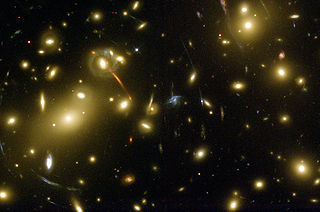
Abell 2218 is a large cluster of galaxies over 2 billion light-years away in the constellation Draco.

An intermediate-mass black hole (IMBH) is a class of black hole with mass in the range 102–105 solar masses: significantly more than stellar black holes but less than the 105–109 solar mass supermassive black holes. Several IMBH candidate objects have been discovered in our galaxy and others nearby, based on indirect gas cloud velocity and accretion disk spectra observations of various evidentiary strength.

A dwarf galaxy is a small galaxy composed of about 1000 up to several billion stars, as compared to the Milky Way's 200–400 billion stars. The Large Magellanic Cloud, which closely orbits the Milky Way and contains over 30 billion stars, is sometimes classified as a dwarf galaxy; others consider it a full-fledged galaxy. Dwarf galaxies' formation and activity are thought to be heavily influenced by interactions with larger galaxies. Astronomers identify numerous types of dwarf galaxies, based on their shape and composition.

The Norma Cluster (ACO 3627 or Abell 3627) is a rich cluster of galaxies located near the center of the Great Attractor; it is about 68 Mpc (222 Mly) distant. Although it is both nearby and bright, it is difficult to observe because it is located in the Zone of Avoidance, a region near the plane of the Milky Way. Consequently, the cluster is severely obscured by interstellar dust at optical wavelengths. Its mass is estimated to be on the order of 1015 solar masses.
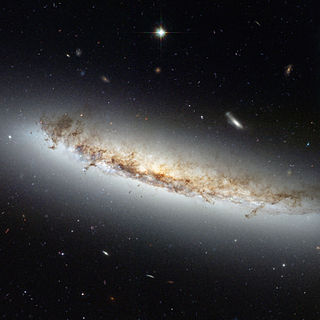
Ram pressure is a pressure exerted on a body moving through a fluid medium, caused by relative bulk motion of the fluid rather than random thermal motion. It causes a drag force to be exerted on the body. Ram pressure is given in tensor form as
The Milky Way has several smaller galaxies gravitationally bound to it, as part of the Milky Way subgroup, which is part of the local galaxy cluster, the Local Group.
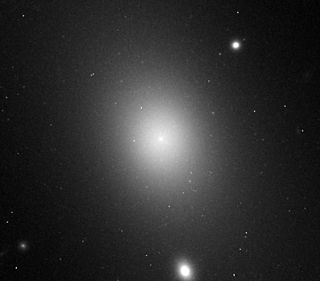
IC 1101 is a class S0 supergiant (cD) lenticular galaxy at the center of the Abell 2029 galaxy cluster. It has an isophotal diameter at about 123.65 to 169.61 kiloparsecs. It possesses a diffuse core which is the largest known core of any galaxy to date, and also hosts a supermassive black hole that is one of the largest black holes known. The galaxy is located at 354.0 megaparsecs from Earth. The galaxy was discovered on 19 June 1790, by the British astronomer William Herschel.

The Comet Galaxy, a spiral galaxy located 3.2 billion light-years from Earth, in the galaxy cluster Abell 2667, was found with the Hubble Space Telescope. This galaxy has slightly more mass than our Milky Way. It was detected on 2 March 2007.
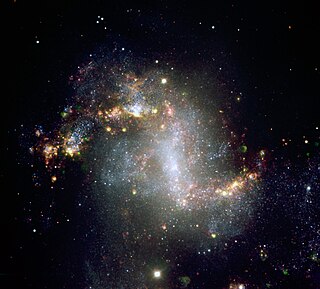
NGC 1313 is a field galaxy and a barred spiral galaxy discovered by the Scottish astronomer James Dunlop on 27 September 1826. It has a diameter of about 50,000 light-years, or about half the size of the Milky Way.

ESO 137-001 is a barred spiral galaxy located in the constellation Triangulum Australe and in the cluster Abell 3627. As the galaxy moves to the center of the cluster at 1900 km/s, it is stripped by hot gas, thus creating a 260,000 light-year long tail. This is called ram pressure stripping. The intergalactic gas in Abell 3627 is at 100 million Kelvin, which causes star formation in the tails.

Abell 2744, nicknamed Pandora's Cluster, is a giant galaxy cluster resulting from the simultaneous pile-up of at least four separate, smaller galaxy clusters that took place over a span of 350 million years, and is located approximately 4 billion light years from Earth. The galaxies in the cluster make up less than five percent of its mass. The gas is so hot that it shines only in X-rays. Dark matter makes up around 75 percent of the cluster's mass.
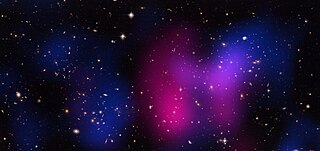
The Musket Ball Cluster is a galaxy cluster that exhibits separation between its baryonic matter and dark matter components. The cluster is a recent merger of two galaxy clusters. It is named after the Bullet Cluster, as it is a slower collision, and older than the Bullet Cluster. This cluster is further along the process of merger than the Bullet Cluster, being some 500 million years older, at 700 million years old. The cluster was discovered in 2011 by the Deep Lens Survey. As of 2012, it is one of the few galaxy clusters to show separation between its dark matter and baryonic matter components.
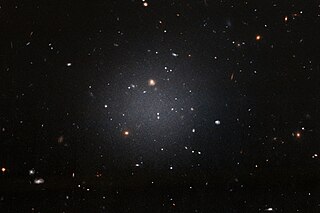
An ultra diffuse galaxy (UDG) is an extremely low luminosity galaxy, the first example of which was discovered in the nearby Virgo Cluster by Allan Sandage and Bruno Binggeli in 1984. These galaxies have been studied for many years prior to their renaming in 2015. Their lack of luminosity is due to the lack of star-forming gas, which results in these galaxies being reservoirs of very old stellar populations.

A2744_YD4 is a very distant young galaxy. This galaxy has first been identified as a possible distant galaxy in 2015 using the Hubble Space Telescope. This detection was made possible because this galaxy lies behind the massive galaxy cluster Abell 2744. In 2017, ALMA observed it and detected a small quantity of dust and the first signature of Oxygen emitting light only 600 million years after the Big Bang.
The KBC Void is an immense, comparatively empty region of space, named after astronomers Ryan Keenan, Amy Barger, and Lennox Cowie, who studied it in 2013. The existence of a local underdensity has been the subject of many pieces of literature and research articles.



















